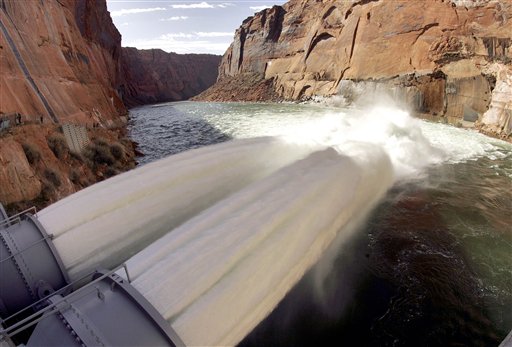Manmade flood unleashed in Grand Canyon; meant to boost ecosystem by redistributing sediment

Water flows from the number one and two jet tubes at the Glen Canyon Dam Wednesday, March 5, 2008 in Page, Ariz. The Department of Interior is experimenting with high flows of water from the dam to help, in part, to rebuild beaches along the Colorado Rive Matt York, The Associated Press
March 5, 2008
PAGE, Ariz. – Twin torrents of water unleashed from a dam coursed through the Grand Canyon on Wednesday in a flood meant to mimic the natural ones that used to nourish the ecosystem by spreading sediment.
“This gives you a glimpse of what nature has been doing for millions of years, cutting through and creating this magnificent canyon,” Interior Secretary Dirk Kempthorne said after he pulled the lever releasing the water from Glen Canyon Dam, upstream from Grand Canyon National Park.
More than 300,000 gallons of water per second were being released from Lake Powell above the dam near the Arizona-Utah border. That’s enough water to fill the Empire State Building in 20 minutes, Kempthorne said.
The water gushed from the dam into the Colorado River below, creating a churning, frothy pool that glided past the salmon-colored sandstone walls of the canyon.
The dam is releasing four to five times its usual flow during the three-day flood. The water level in the canyon will only rise a few feet, but officials hope that will be enough to restore sandbars on the Colorado River downstream from the dam. Officials have flooded the canyon twice before, in 1996 and 2004.
Get The Daily Illini in your inbox!
Before the dam was built in 1963, the river was warm and muddy, and natural flooding built up sandbars that are essential to native plant and fish species. The river is now cool and clear, its sediment blocked by the dam.
The change helped speed the extinction of four fish species and push two others, including the endangered humpback chub, near the edge.
Shrinking beaches have led to the loss of half the camping sites in the canyon in the past decade. Since Glen Canyon Dam was built, 98 percent of the sediment carried by the Colorado River has been lost, Grand Canyon National Park Superintendent Steve Martin said.
Martin said man-made floods need to occur every time there’s enough sediment to do so – about every one to two years depending on Arizona’s volatile monsoon season.
“The science is really clear that’s what we need to do,” Martin said.
The Grand Canyon Trust, a Flagstaff-based group that has been critical of the federal Bureau of Reclamation’s management of the dam, also is calling for more regular high flows.
“The power industry is driving the Bureau of Reclamation more than anything else, as opposed as to what’s best for the canyon,” trust spokesman Richard Mayol said.
Scientists will document habitat changes and determine how backwater habitats are used by the chub and other fish. Another study will look at how higher water flows affect the aquatic food base.






